At the end of 2024, we identified 10 potential events and surprises likely to impact financial markets and the global economy this year. These are not forecasts, but potential macroeconomic, geopolitical ,or market events that are not anticipated by the financial markets. As these developments unfold, their implications could ripple across asset classes, reshaping investor expectations and global economic dynamics.
Without question, the first half of 2025 has been anything but ordinary. From breakthrough AI launches to military escalations, from stubborn inflation to credit downgrades, to tariff disputes disrupting global trade, the past six months have revealed that fundamental changes are underway. Markets have been volatile, traditional partnerships have been tested, policymakers are scrambling to adapt, and investment decisions are being reconsidered.
SURPRISE #1
TRUMP 2.1
[unrealised]
Mid-Year:
Trump’s “Trump 2.0” tariff plan, which proposed a 10–20% tariff on all imports and up to 60% on Chinese goods, escalated trade tensions earlier this year. These tensions peaked with the US imposing tariffs as high as 145%, prompting Chinese retaliatory tariffs of up to 125%. However, a May 2025 Geneva agreement reduced these to 30% and 10%, respectively, with a 90-day pause extended after London talks in June.
China eased rare earth mineral restrictions, and the US relaxed some export controls, but no broad trade agreement materialised. Inflation concerns moderated tariffs, yet no significant easing of geopolitical tensions (e.g., Taiwan, intellectual property) occurred. The EU hasn’t secured a comparable deal, and China’s equity market hasn’t rebounded. The Federal Reserve has maintained restrictive monetary policy, opting not to initiate quantitative easing or amid ongoing economic uncertainty.
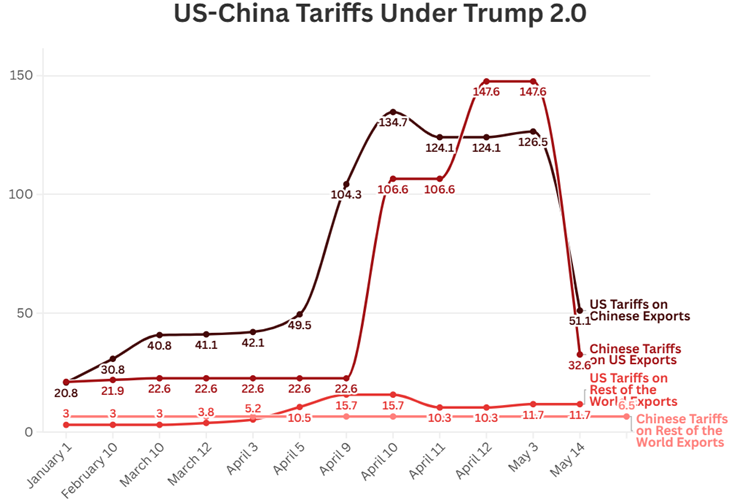
Source: Peterson Institute for International Economics
SURPRISE #2
THE US ECONOMY FACES “SLUGFLATION”
[unrealised]
Mid-year:
Our anticipated surprise of low , rising wages, and a Chinese economic rebound partially aligns with reality, but key elements missed the mark. US immigration policies kept unemployment at 4.1% in June 2025, with wages rising modestly.
China’s grew 5.2% in Q2, boosting energy prices, but non-energy commodities dipped. at 2.4% exceeds the Fed’s 2% target, delaying , but the Fed maintained 4.25%–4.50% rates and slowed Quantitative Tightening without restarting Quantitative Easing. The suggested “slugflation” did not occur. No recession emerged, and the budget deficit stands at 6.2% of . Our anticipated surprise overstated Fed policy shifts and economic downturn severity.

Source: U.S. Bureau of Labor Statistics via FRED
SURPRISE #3
“DOGE” GOES GLOBAL
[unrealised]
Mid-year:
The anticipated surprise about the Department of Government Efficiency (DOGE) measures, led by Elon Musk and Vivek Ramaswamy, partially materialised but fell short of expectations. DOGE, established by executive order on 20 January 2025, aimed for a 25% federal workforce reduction, triggering some resignations, though not as widespread as predicted. Globally, only Argentina followed with similar efficiency measures, not the broad adoption anticipated, and corporate “DOGE” equivalents were limited, with no significant impact on bond yields.
In Europe, social unrest occurred, but French President Emmanuel Macron did not resign, and no populist government emerged in France. DOGE achieved $150 billion in cuts by April 2025, far below the $2 trillion goal, with savings disputed and offset by $135 billion in implementation costs. The forecast overestimated global adoption, social unrest outcomes, and economic impacts.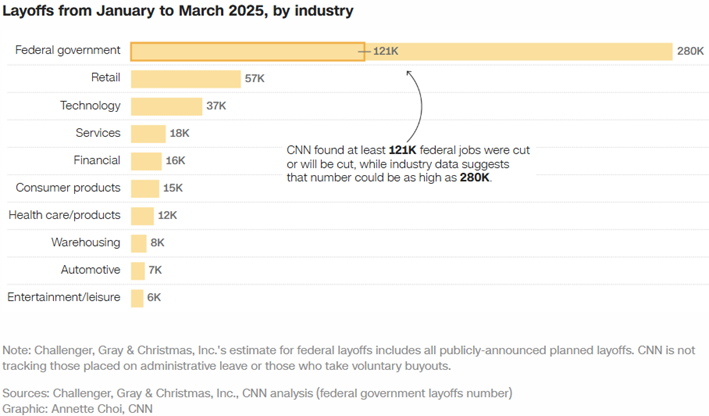
Source: CNN
SURPRISE #4
GERMANY PUSHES FOR FISCAL STIMULUS
[partially materialised]
Mid-year:
The surprise of a CDU-led coalition relaxing Germany’s debt brake after the 23 February elections proved accurate, with Friedrich Merz’s coalition implementing a €500 billion stimulus for infrastructure and defence to revive a stagnant economy, as reported by DW and NYT. However, the anticipated economic boost was overstated, with Germany’s growth at just 0.3% in 2025, per the European Commission.
Discussions on European bonds for structural investments occurred but lacked agreement, partially aligning with the anticipated surprise. Public debt rose, with Germany’s debt-to-GDP ratio projected at 64.7% by 2026, in line with expectations. Contrary to expectations, Eurozone fell to 1.9% in May 2025, below the ECB’s 2% target, and the ECB continued to 2.25% by April, not halting early. Sovereign bond yields rose to 3.18%, as expected.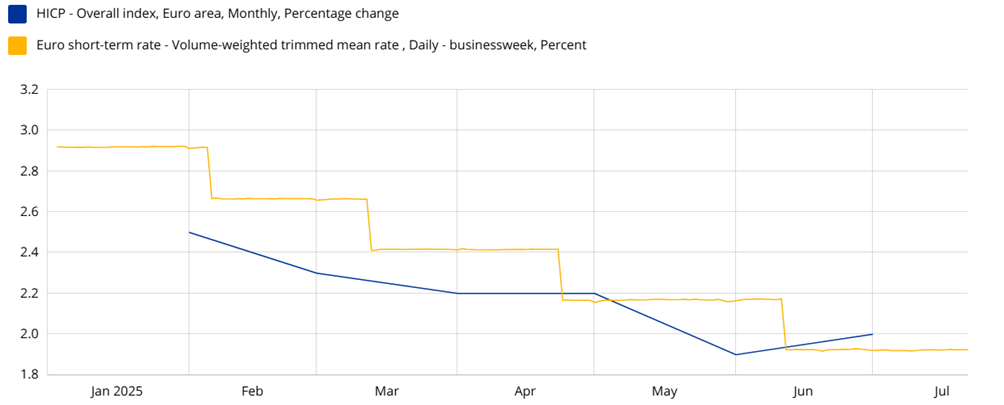
Source: EUROSTAT, ECB
SURPRISE #5
BRICS+ ADOPT BITCOIN AS AN ALTERNATIVE TO THE DOLLAR
[unrealised]
Mid-year:
The anticipated surprise that BRICS would launch a blockchain-based payment system in 2024 and adopt as a reserve currency in 2025, driving its price to $500,000, was largely inaccurate. BRICS announced “BRICS Pay” in March 2024 to reduce reliance on the and SWIFT, but by July 2025, it remains in development, not fully implemented, facing interoperability and security challenges.
The expectation overestimated bitcoin adoption and price surge, with only partial success in forecasting payment system plans and bond yield increases. Despite bitcoin not being adopted as a reserve currency, institutional interest in cryptocurrencies has been growing. In 2025, several emerging market countries, such as Brazil and South Africa, have approved spot Bitcoin ETFs. Additionally, BRICS central banks including Russia, India, and China have expanded pilot programs for blockchain-based settlements and tokenised assets.
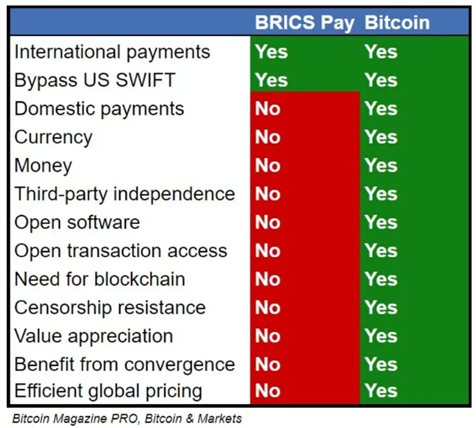
Source: Bitcoin Magazine Pro, Bitcoin & Markets
SURPRISE #6
FROM MAG7 TO LAG7
[partially materialised]
Mid-year:
We anticipated that Nvidia (NASDAQ:) would come under pressure from Chinese rivals, especially Huawei’s Ascend 910C, and that US export restrictions would weaken Nvidia and ripple through the Magnificent 7. Mid‑year, Nvidia remains the AI infrastructure leader. Yet the geopolitical and technological tensions did materialise.
In late January, Chinese AI startup DeepSeek released an open-source model matching GPT‑4-level performance, despite lacking access to Nvidia’s top-tier chips. The shock was immediate—Nvidia lost roughly $600 billion in market capitalisation in a single trading day, the largest single-day loss in US equity history.
The stock managed to recover over the following months, ending the first half of the year with a +16.2% return. Meta (NASDAQ:) was the top performer among the Magnificent 7, gaining +25.2%, followed by Microsoft (NASDAQ:) with +16.9%. Amazon (NASDAQ:) and Alphabet (NASDAQ:) posted modest losses of -1.2%% and -7.4%, respectively, while Apple (NASDAQ:) and Tesla (NASDAQ:) underperformed significantly, falling −17.6% and −18.6% over the same period.
On average, the group delivered a muted +1.9% return, driven by resilience in AI-linked names and dragged down by cyclical weakness in consumer tech and autos.
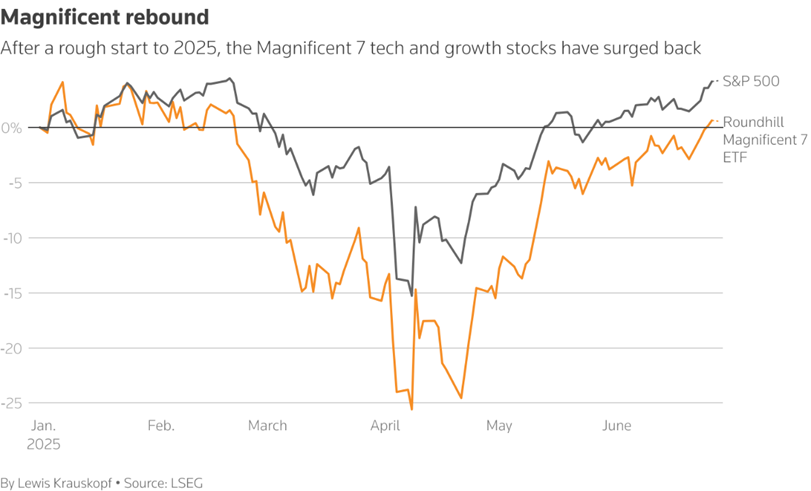
Source: Reuters
SURPRISE #7
A US-OPEC+ CLASH
[partially materialised]
Mid-year:
production has increased by just 0.1 million barrels per day since December 2024, falling well short of the 3 million daily increase associated with the “3-3-3” framework. However, OPEC+ appears to be gradually increasing supply, likely to protect or regain market share.
While this does not amount to a full-scale flooding of the market, it suggests that the countermove envisaged in the original surprise scenario is beginning to take shape. Oil prices have slipped below USD 70, above the projected USD 50, but notably subdued given the geopolitical tensions of the first half of the year.
More broadly, while the growth target shows partial alignment, there has been little progress on deficit reduction or US-led supply expansion. As a result, the “3-3-3” plan has only partially materialised, with some elements of the anticipated surprise now unfolding.
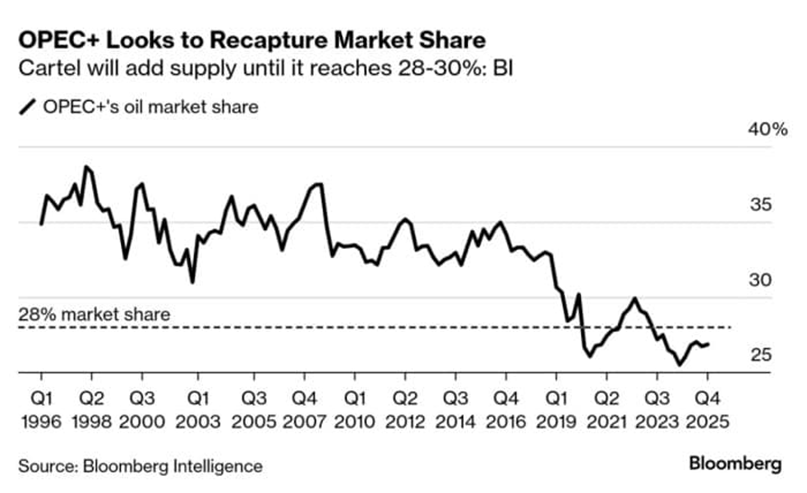
Source: Bloomberg
SURPRISE #8
NEAR-ZERO INFLATION IN EUROPE; NEGATIVE RATES RETURN IN SWITZERLAND
[materialised]
Mid-year:
The anticipated surprise of political and economic instability in Europe has been largely accurate. Political crises in France and Germany have disrupted governance and weakened investor confidence, contributing to economic stagnation. Eurozone inflation declined, prompting the European Central Bank to cut its deposit rate to 2% by June 2025 and signal readiness for further easing if necessary.
While the ECB has not formally reintroduced quantitative easing, it has maintained a strong easing bias to prevent fragmentation. In Switzerland, the Swiss National Bank reduced interest rates to zero in June 2025 to counter persistent low inflation, which stood around minus 0.1%, and a strong .
Although the has not fallen as low as 85 cents against the franc, it remains under pressure. Overall, the core elements of the surprise were largely correct, with political instability, falling inflation, and forceful central bank responses all materialising.
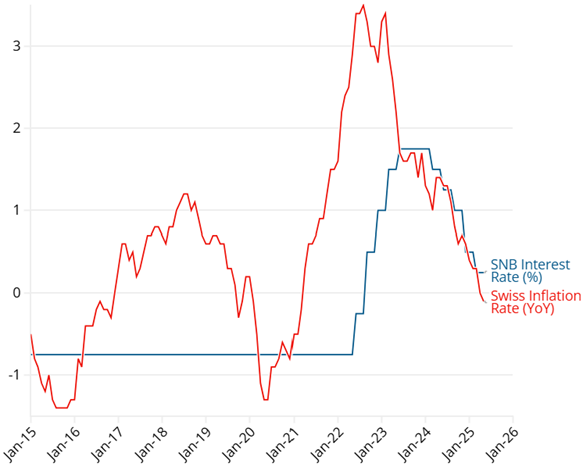
Source: TradingView, euronews
SURPRISE #9
A MAJOR FUND BLOWS UP
[unrealised]
Mid-year:
Although financial markets have shown signs of stress, the predicted major volatility event caused by concentration in the Magnificent 7, the rise of zero-day options, and unusual cross-asset movements has not occurred. There was a spike in volatility in April 2025 following trade tensions and sharp moves in equities and bonds, but it did not lead to a systemic fund collapse, flash crash, or cascade of forced liquidations.
Concerns over low market liquidity, options-driven instability, and concentrated risk remain active topics among analysts and institutions, but no large fund has unravelled in a way comparable to past events like LTCM or Volmageddon.
Source: Generated with DALLE
SURPRISE #10
ELON MUSK & GEORGIA MELONI GET MARRIED; TRUMP & MUSK GO FROM BFF TO FOES
[partially materialised]
Mid-year:
Musk and Meloni have maintained a professional but still close relationship. Musk showed interest in investing in Italy, including discussions around significant deals such as a €1.5 billion SpaceX contract. On the other hand, the forecast regarding Musk’s deteriorating relationship with President Donald Trump proved accurate.
Musk publicly left the Department of Government Efficiency (DOGE) in May 2025 after disagreements with President Trump, leading to leadership turmoil and staff resignations within DOGE. The fallout was largely driven by diverging views on electric vehicle policy, as Musk pushed back against Trump’s plans to eliminate federal EV incentives.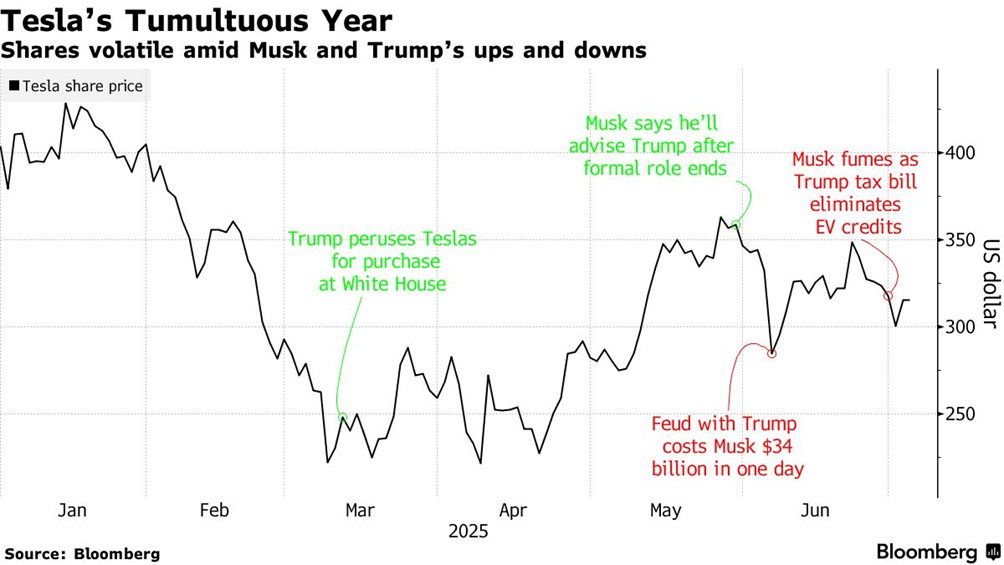
Source: Bloomberg
Conclusion
The future is a dice roll. Five of our ten potential surprises materialised or came close to materialise. As the year continues, the dice are still in play and many scenarios can unfold.
